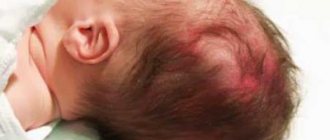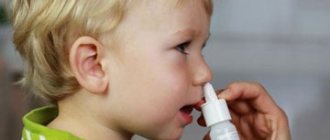The disease was named chickenpox because of the high contagiousness (volatility) of the virus; it can be said to be carried by the wind. The main distinguishing sign of infection is a specific chickenpox rash, the appearance of which is accompanied by a rise in temperature and unbearable itching. All this, and especially the itching, causes considerable discomfort to the child. It is unlikely that the baby will be able to resist scratching the itchy rash. Scratching that appears on the skin is an excellent environment for pathogenic bacteria that cause pustular diseases. That is why special attention must be paid to maintaining hygiene. Many mothers and fathers, who understand the importance of hygiene procedures, are interested in whether it is possible to swim with chickenpox. It depends on the course of the disease and the baby’s well-being.
When is swimming allowed?
Treatment of chickenpox is mainly local. It consists of treating all elements of the rash with antiseptics; only in severe cases are antiviral agents prescribed. As for the issue of bathing, doctors differ in their opinions.
Until recently, pediatricians did not allow mothers to bathe children who had chickenpox until the last scab fell off. Doctors believed that taking a bath or shower contributed to the spread and enlargement of the rash, as well as the deterioration of the child’s general condition. But thanks to the fact that science does not stand still, today the effect of the virus on the body and the mechanism of development of chickenpox have been studied in more detail. Therefore, we can say with confidence that bathing a child is possible and even useful, subject to certain conditions, although some old-school doctors still prohibit washing.
But European doctors recommend short-term water procedures for patients with chickenpox several times during the day, believing that they have a beneficial effect on the course of the disease.
Swimming after treatment
After chickenpox, your baby's skin remains at risk for several weeks. She is traumatized by wounds, some papules have turned into scars and may hurt a little. Parents should pay attention to the process of taking bath procedures even after a complete cure.
Bathe your baby every day, you can add medicinal herbs and infusions. Take your time to use hard washcloths, soaps, and shampoos. The skin after chickenpox is tender and dry. Use water or mild baby soap to wash your baby's bottom and hands after going outside.
Do not abuse baths and saunas. High air temperatures and high humidity in the steam room after chickenpox are contraindicated for children for another 2-3 weeks. If you live in a country or village house where there is no bath, wash your baby in a basin in the living room.
Do not heat the water above 37-38 °C.
How to properly bathe a baby if he has chickenpox?
Almost every child loves to swim, and the absence of water procedures for 7 - 10 days, while the rash lasts, deprives him of positive emotions, which are so lacking during illness. Bathing reduces itching, soothes, dries out rashes and improves the child’s well-being. If chickenpox occurs without complications and there is no fever, then it will only be beneficial. To prevent bathing from causing harm, you must follow a few simple rules:
- Prepare a decoction of herbs that have an antiseptic, soothing, drying and itching effect (chamomile, oak bark, string). Add it to the water while bathing. In the absence of medicinal herbs, a slightly pink solution of potassium permanganate is well suited for this purpose.
- Use bathtubs to bathe babies; older children can be bathed in the shower.
- Don't make the water hot. You should not steam your child. The water should be pleasantly warm to rinse away sweat, relieve itching and lift your spirits.
- Don't get carried away and don't delay your bathing. 5 - 10 minutes will be enough. But you can wash yourself several times a day (3 - 4).
- Do not rub the rash elements with a washcloth or sponge. Damage to them can lead to infection, and after scabs removed by force, scars may remain on the skin.
- Regular baby soap is best as a detergent. You can wash your child with it no more than 2 times during the entire period of illness. For other baths, use only water.
- After completing the procedure, thoroughly dry the baby’s skin, carefully blotting it with a soft towel or diaper, which should be changed after each bath.
- After the skin is completely dry, treat each spot, blister and crust with an antiseptic (brilliant, fucorcin, 5% solution of potassium permanganate). Wear clean underwear.
Important! To prevent your child from getting an infection when scratching, trim your nails short. You should also wash your hands more often than usual.
These rules, which are not difficult to follow, allow you not to give up water procedures and maintain body cleanliness, minimizing the risk of infection.
You can swim the way you like, taking with you your favorite washcloth, gel and bubble bath, when there is not a single crust left. Just don't overdo it. You shouldn't splash around for too long. The body has not yet fully recovered, and the immune system is weakened after the illness.
When can you bathe your baby?
- If there is no high temperature.
- The baby doesn't mind taking a bath.
- The disease occurs without pustules, there are no secondary infections on the skin.
If the child is weakened and categorically against bathing, wait a few days. 3-5 days after the rash, the disease subsides and the mood improves.
Important! 1-2 days of illness development are not suitable for swimming in most cases. The baby has a fever, is capricious, lies in bed, and the disease is actively developing. These days, it is enough to wipe it with a disposable wet napkin, wash it after using the toilet, and wash your face after eating.
3-5 days after the first rash, when a crust begins to form on the papules, you can completely bathe the child or take a light shower.
And here is what Dr. Komarovsky thinks about this:
When is swimming with chickenpox contraindicated?
Despite the fact that baths for chickenpox reduce itching, bathing some children is still not recommended, so as not to worsen the course of the disease.
Swimming is prohibited:
- When the temperature is elevated. Even a slight increase is a contraindication.
- In the presence of purulent rashes.
- In case of severe chickenpox and the development of complications.
In almost every child, in the first two days of the onset of the disease, the temperature rises and persists. At this moment, the child should be in bed, and of course you should not wash him. If the temperature persists throughout the illness, you should refrain from swimming until recovery. In this case, you can only wipe the baby with a soft, damp cloth. It will be possible to swim completely when the disease subsides and the temperature returns to normal.
The child should be washed daily, even if bathing is prohibited. With chickenpox, rashes are located throughout the body and often appear in the genital area, and in the absence of hygiene, the skin and mucous membranes become irritated and inflamed. To prevent this from happening, wash your baby with chamomile or oak bark decoctions every day. They reduce the intensity of itching, relieve irritation and disinfect, preventing the development of inflammation.
Varicella (chickenpox)
Chickenpox (varicella) is a highly contagious acute infectious disease that occurs with a characteristic blistering rash.
Children who attend kindergarten or school—places with large crowds of people—get sick more often.
The disease is caused by one of the herpes viruses (herpesvirus type 3). Chickenpox is a highly contagious disease. The virus is transmitted from a sick person to a healthy person through airborne droplets (during conversation, staying in one small room). With a current of air, chickenpox can spread over long distances (up to 20 m). Infection can also occur from a patient with herpes zoster (caused by the same type of herpes virus). The virus is not stable in the external environment, so final disinfection after the patient is not carried out.
A person with chickenpox becomes contagious two days before the rash appears, and remains contagious for the first 5-7 days after the rash appears.
The incubation period for chickenpox is 7-21 days. The virus enters the human body through the mucous membranes of the nose, mouth and pharynx. The virus is then carried throughout the body by lymph and blood, penetrating the skin and mucous membranes, where it multiplies. The targets for the virus are cells of the spinous layer of the skin and the epithelium of the mucous membranes. After the primary infection, the virus resides for life in the neurons of the spinal ganglia, facial ganglia and trigeminal nerves. Like all herpes viruses, the varicella-zoster virus has the ability to suppress the immune system, which leads to disruption of the humoral and cellular immune response and disruption of innate resistance factors to infections.
Immunity for chickenpox is non-sterile i.e. causes immunity to new infection and does not ensure removal of the virus from the body. The virus resides for life in the spinal ganglia, the nuclei of the cranial nerves, which are associated with the areas of the skin most affected by the primary infection. Reactivation of the virus occurs in conditions of weakened immunity in the form of herpes zoster.
Symptoms of chickenpox in children
The disease manifests itself primarily as a feverish state, a sharp increase in body temperature to 39-40 degrees, and headache. The most obvious sign of chickenpox is a rash and itching.
A rash in the form of small, fluid-filled blisters can cover a significant part of the body and mucous membranes. The bubbles burst rather quickly and turn into small ulcers, which must be treated with an aqueous solution of brilliant green or potassium permanganate, acyclovir and other ointments as prescribed by the doctor. As the rash heals, it becomes covered with a crust, which gradually disappears, thereby demonstrating recovery. Usually the rash heals without a trace, but if you scratch it, scars may remain on the skin after healing.
In children, chickenpox occurs in a simpler form than in adults, who may suffer from complications in the future.
It is extremely rare that chickenpox can occur without rashes and blisters - in this case, additional consultation with a specialist is necessary to clarify the diagnosis.
Chickenpox treatment
Chickenpox usually goes away on its own within a week or 10 days. In this case, the temperature can normalize within two to three days, although, in some cases, it persists throughout the entire period of the illness.
Treatment of chickenpox is symptomatic (i.e., the manifestations of the disease are treated: high fever, skin rash), since medicine at this stage does not know either ways to prevent or treat this disease. The goal of treatment is to prevent the blisters from becoming suppurated. For this, brilliant green is perfect; you can use Castellani liquid, an aqueous solution of fucorcin or potassium permanganate, etc. Children tolerate alcohol solutions very painfully.
It is necessary to bathe a child with chickenpox to prevent secondary skin infections. In this case, you should not use a washcloth and it is better not to use soap, adding a weak solution of potassium permanganate to the bath. Create the most comfortable conditions for your baby's skin: do not wear thick or tight clothes, use only cotton underwear.
If your child is bothered by severe itching, tell the doctor about it: he will prescribe antiallergic medications.
If the temperature rises above 38°C or chills, the child must be given antipyretics (paracetamol, ibuprofen).
A person with chickenpox is isolated at home for nine days from the onset of the disease. In preschool institutions, a quarantine period of 21 days is established.
Complications of chickenpox
Complications of chickenpox are rare and are most often associated with inaccurate treatment of rashes and their suppuration, which subsequently leads to the formation of scars.
It is extremely rare for weakened children to experience severe forms of chickenpox with damage to the brain and internal organs. Such forms of the disease are treated in hospitals using special therapeutic methods.
Chickenpox vaccine and vaccination
The vaccine sufficiently protects against chickenpox and its complications. It is recommended for children 12 months of age and older, as well as for adolescents and adults who have not previously had chickenpox or been vaccinated. The vaccine protects against the disease for 10 years or more. In rare cases, people who have received the chickenpox vaccine may get chickenpox, but the illness will be mild.
Currently, in the USA, Japan and some other countries, vaccination against chickenpox is mandatory for admitting a child to a preschool. But in Russia, vaccination of children against chickenpox has not yet become widespread, and this remains the choice of parents.
It is worth noting that some people with weakened immune systems (due to illness or taking medications that affect the immune system) should not get vaccinated, as they may develop complications. Therefore, before receiving chickenpox vaccine in a patient with a weakened immune system, you should consult your doctor.
Chickenpox in children
Chickenpox or varicella remains one of the most common infectious diseases today, affecting children between the ages of six months and ten years.
Chickenpox or varicella remains one of the most common infectious diseases today, affecting children between the ages of six months and ten years. Adults also get chickenpox, but it is less common and more severe.
How is chickenpox transmitted?
In a large group of children, chickenpox can be epidemiological in nature and alternately affect each member of the group.
It is known that the disease is provoked by one of the herpes viruses and is extremely contagious, although in most cases it is not dangerous. The virus quickly passes through airborne droplets from a sick person to a healthy person. However, the person transmitting the disease may not experience symptoms of the disease at that moment. It can infect others several days before the rash and fever appear. So sometimes it is very difficult to trace the source of the disease in advance and prevent its transmission.
Chickenpox has an incubation period of one to three weeks, and symptoms may appear no earlier than seven days after infection, but no later than 21 days.
A person ceases to be contagious a week or ten days after the first signs of chickenpox appear.
Symptoms of chickenpox in children
The symptoms of chickenpox are similar in all children and adults. The disease begins quite abruptly with an increase in temperature, usually up to 38 degrees, but sometimes up to 40 degrees, weakness and headache are noted. But the main symptom of chickenpox is a profuse rash that spreads over the entire surface of the skin and even mucous membranes. The rash in the form of small blisters with liquid is accompanied by severe itching, which children cannot tolerate very well.
The main localization of the rash is the torso, head (face and scalp), genitals, mouth.
The first signs of chickenpox are redness of the skin up to one centimeter in diameter. In their place, after a fairly short time, blisters with a clear liquid appear, which subsequently transform and take on the appearance of dried crusts.
The course of the disease is usually wavy, so rashes may appear several times.
Treatment of chickenpox in children
Treatment of chickenpox in children and adults is aimed at overcoming unpleasant symptoms. The disease itself is not curable, but passes gradually and, as a rule, without a trace. Complications in children are rare; adults are much more susceptible to them.
Since children are prone to scratching the rash, the main treatment should be aimed at relieving itching and preventing suppuration of ulcers and blisters. To do this, the skin is treated with a weak aqueous solution of brilliant green or potassium permanganate, fucrocin or Castellani liquid.
How to treat chickenpox in children and what to use to achieve optimal results is a purely individual question that should be decided by parents together with the attending physician.
Chickenpox in infants
Any child over the age of six months can get chickenpox. As a rule, the course of the disease in an infant is quite complex - infants do not tolerate the symptoms of chickenpox well and require careful care and constant attention from the mother.
Chickenpox in newborns manifests itself with the same symptoms as in older children. However, in a particularly complex form, chickenpox can cause serious harm to the body, affecting the development of internal organs. Treatment of chickenpox in infants should be carried out under the supervision of a specialist.
Chickenpox vaccine
Doctors recommend that children over 12 months of age be vaccinated against chickenpox. It effectively protects the body from this disease for several years.
It is worth saying, however, that a number of experts are of the opinion that it is worth getting chickenpox in childhood and gaining immunity for life, rather than encountering this disease in adulthood and suffering from dangerous
Chickenpox in adults
Chickenpox in adults develops and progresses just as quickly as in children, but is more severe and more likely to cause complications.
Adults who have not had chickenpox in childhood are at risk of becoming ill at an age when the course of this disease and its consequences can be very serious.
How is chickenpox transmitted in adults?
Chickenpox, or chickenpox, is a disease that is actively transmitted from a sick person to a healthy person through airborne droplets. It is quite difficult to protect yourself and your family from it, since it is not always possible to “catch” the moment and understand that communicating with this or that person will lead to illness.
Chickenpox in adults develops and progresses as quickly as in children, after 7-21 days of the incubation period.
A person remains contagious for about a week after symptoms first appear.
Chickenpox symptoms in adults
The symptoms of chickenpox in adults are identical to the symptoms of this disease in children. The temperature rises sharply, a febrile state develops - weakness, headache, loss of appetite and sleep. First, intense redness of the skin appears throughout the body, and then a rash, which is accompanied by severe itching. The rash can cover the torso and back, face and scalp, and mucous membranes of the mouth and genitals. It is extremely rare that chickenpox can occur without a profuse rash, but the percentage of such cases is negligible.
The manifestation of chickenpox symptoms in adults occurs in waves - a rash and high fever appear several times during the week.
The rash usually goes away without a trace - if you don't touch or scratch it. Otherwise, pockets of suppuration may occur, and after they heal, scars and cicatrices may remain.
Treatment of chickenpox in adults
Chickenpox is a disease that usually goes away on its own without specific treatment. However, the symptoms of this disease require attention. This mainly concerns itching and rash, which must be periodically treated with a weak aqueous solution of potassium permanganate or brilliant green, lubricated with acyclovir or other ointment prescribed by the attending physician.
Complications of chickenpox in adults
Chickenpox is dangerous for adults, primarily due to complications - damage to internal organs, pneumonia. Chickenpox is also dangerous for pregnant women - the disease can affect the child and lead to serious prenatal pathologies. Therefore, in adulthood, treatment of chickenpox should be carried out under the supervision of a specialist and only with the drugs that he prescribes.
Is it possible to swim in a river if you have chickenpox?
During the summer holidays, parents of children with chickenpox ask whether it is possible to swim in rivers, lakes and other open bodies of water.
If the baby does not have a fever and feels well, then bathing will not harm him. However, pediatricians do not allow visiting places with large crowds of people with chickenpox, since this disease is very contagious. And in summer the beach is always full of people. Therefore, responsible parents who do not want healthy children and adults who were not sick in childhood to become infected will not take a sick child to the beach.
In addition, when there are many rashes and the child is constantly itching, his skin is injured, and there is a risk of additional infection and suppuration of the rash elements. The purity of water in our reservoirs, unfortunately, is very doubtful. Given this fact, pediatricians do not recommend swimming in them if you have chickenpox.
Possible complications
As a rule, the disease goes away without serious consequences, especially if you do not scratch the papules. However, in rare cases, complications after chickenpox can still occur.
Among them:
- bacterial infection caused by streptococcus;
- viral pneumonia, which is more common in children of the first year of life and manifests itself in the form of high body temperature, excessive paleness of the skin, dry cough and severe shortness of breath even at rest;
- temporary disruption of the central nervous system;
- encephalitis;
- chickenpox meningitis.
To avoid such consequences, monitoring of the development of the disease and treatment must be carried out under the supervision of a physician - therapist, pediatrician or infectious disease specialist.
A few tips to help relieve chickenpox
It will be easier for both children and adults to tolerate chickenpox if:
- the house (apartment) is not too hot. When the house is very warm, you sweat more and more often, and this increases the itching;
- bed linen and home clothes are made from natural fabrics (cotton, linen). They allow the skin to breathe. Synthetics are irritating and only increase the itching. In addition, it does not allow air to pass through, so the body sweats and discomfort increases. Don't forget to change your linen daily;
- drink more. This helps eliminate intoxication;
- if there are rashes in the mouth, you should rinse your mouth with a solution of chamomile or furatsilin as often as possible;
- Take antihistamines when the itching becomes unbearable. The doctor selects the drug and dosage;
- treat the rash 3 - 4 times a day. This way it dries faster and does not become infected.
How chickenpox occurs was first described by Italian doctors in the 16th century. And the cause of the disease was identified only in 1958.
In a child who has had chickenpox, the virus that causes the disease settles in the nerve cells and remains in the body for life. This is why 99% of the population gets sick once in their life, and only a small percentage of people (1%) get sick again. A virus dormant in the body, when the immune system is weakened, can be activated and cause shingles.
A vaccine against chickenpox has been available since 1994. In Russia, it became available only in 2009, but it was never included in the vaccination calendar. Developed countries (Japan, USA) have included the vaccine in the childhood immunization program and have been successfully using it for more than 10 years. Japanese scientists have found that immunity after vaccination lasts for 10 to 20 years.
Answers to common questions
Is there a way to prevent chickenpox?
The preventive measure – not to contact people who are sick – is not always effective. The fact is that infection can occur even before the first manifestations of the disease are detected in the patient. That is, he can communicate with friends without knowing that he is contagious.
It is possible to prevent the onset of the disease by vaccination with special live vaccines, which are based on a weakened chickenpox virus.
Which specialist should I contact for treatment?
Chickenpox in children is treated by a pediatrician or pediatric infectious disease specialist. If an adult gets sick, you should call a therapist or an adult infectious disease specialist immediately after detecting the first symptoms of chickenpox.
Is it possible to swim if you have chickenpox?
Due to the fact that the quality of tap water in most cities leaves much to be desired, in case of this disease you should take a shower (not a bath) using boiled or filtered water. Otherwise, there may be a risk of a bacterial infection joining the viral form, which, in turn, can cause serious complications. It is better to wash with warm water. It is strictly forbidden to use a washcloth, rub the skin or steam it.
When can you go for a walk after chickenpox, on what day?
Regarding walking during chickenpox, pediatricians have different opinions. Some people believe that you should never walk outside in order to avoid infecting children. But some doctors believe that walking helps strengthen the immune system and speed recovery. Therefore, it is recommended to walk with your child away from playgrounds and public places. You can take a walk in the park.
Choose comfortable, comfortable clothes so that your child does not rub anything. During illness, do not attend events, do not go to the circus with your child. Do not take him to any exhibitions or playgrounds. You should stay away from people and especially children.
The incubation period for chickenpox is 3 weeks. During these three weeks the child is contagious. The infection is transmitted by airborne droplets. A lot of viral cells are in the fluid that flows out after the ulcers rupture.
Swimming with chickenpox
Tips for caring for someone with chickenpox
Finally, it is worth listing general tips for caring for children with chickenpox.
- The child should not go for a walk. During the period of illness, the child should be at home and have minimal contact with other people. You can start leaving the house only 5 days after the rash goes away: then the child will no longer be contagious.
- Although it is allowed to wash during chickenpox, it is better to wait with swimming pools, baths and other water procedures until complete recovery. The child should be in the water to a minimum.
- Avoid overheating. In spring and summer it can be quite hot outside, but in winter, on the contrary, it gets very hot indoors. Carefully monitor the temperature in your home, as overheating worsens the itching.
- The scabs should be smeared with brilliant green or fucorcin every day. They should dry out and eventually fall off on their own.
- Rashes can even form in the mouth. In this case, it is necessary to rinse with a weak solution of miramistin, furatsilin or other disinfectants.
- The child should eat foods containing vitamins and drink plenty of fluids.
Quarantine for chickenpox
Now you know when you can wash with chickenpox, how long you need to wait until the child can go outside and how to generally care for your baby during this disease.
Remember that in general, chickenpox is practically not dangerous for children. Almost always it is easy and painless. But in adolescents and adults it occurs in a much more severe form, so the sooner your child gets chickenpox, the better. leave a comment
Is it possible to wash my hair
A separate question is whether it is permissible to wash your hair if you have chickenpox. Of course, dirty hair increases the desire to wash, but washing your hair is a more delicate process than regular bathing and should be approached with more caution.
It is recommended to wash your hair no earlier than five days after the onset of the disease. It is important that the child feels well and does not have a high temperature.
Be sure to wash your hair separately from your body. Do not use shampoos or soap, wash your hair exclusively with warm water. The maximum that can be added is an infusion of chamomile or celandine.
Treatment of chickenpox rashes
Never rub your head with a towel. Pat your hair lightly after washing and try to dry it as quickly as possible to prevent hypothermia. The towel must be washed immediately and a new one used the next time you wash it.










